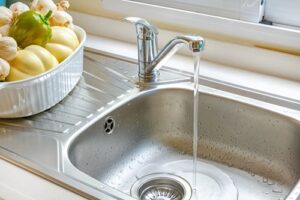In the heart of every home, the humble faucet stands as a silent yet indispensable hero, facilitating daily tasks with the turn of a handle. From washing dishes to quenching our thirst, we rely on these fixtures countless times without giving them a second thought—until, of course, they start to misbehave.
Homeowners often find themselves grappling with a myriad of faucet-related challenges, turning what should be a simple act of obtaining water into a frustrating experience. Leaks, drips, low water pressure, and mysterious noises can disrupt the smooth functioning of these essential fixtures.
In this comprehensive guide, we delve into the world of common faucet problems, shedding light on the issues that plague homeowners and providing practical solutions to restore the flow. Whether you’re contending with a persistent drip that keeps you awake at night or battling low water pressure that hampers your daily routines, this article aims to empower homeowners with the knowledge needed to address and overcome these challenges. 
Join us as we navigate the intricacies of faucet maladies, helping you transform your home’s water sources into reliable allies rather than troublesome adversaries.
Leaking Faucet
A leaking faucet is a common and often vexing issue faced by homeowners, and it can manifest in various ways, from a steady drip to a more persistent flow. Here’s a more detailed look at the problem of a leaking faucet.
Causes of Leaks:
Worn-Out Washers: Over time, the rubber washers inside the faucet can degrade due to constant use, leading to leaks.
Damaged O-Rings: O-rings create a watertight seal in various parts of the faucet. When these rubber rings become damaged or worn, leaks can occur.
Corroded Valve Seat: The valve seat is the connection between the faucet and the spout. Corrosion in this area can result in leaks.
Loose Parts: Faucet components can loosen over time, causing water to seep through the gaps.
Identifying a Leaking Faucet:
Audible Drips: The most obvious sign is the sound of dripping water. This may occur constantly or intermittently.
Visible Water: Puddles or water stains around the base of the faucet or in the sink are clear indicators of a leak.
Increased Water Bills: Unexplained spikes in water bills could suggest an ongoing leak.
Potential Consequences:
Water Wastage: Even a slow drip can contribute significantly to water wastage over time, impacting both the environment and your utility bills.
Mold and Mildew: Persistent leaks can lead to the growth of mold and mildew, posing health risks and requiring additional cleanup efforts.
Structural Damage: Water seeping into cabinets or countertops can cause structural damage and compromise the integrity of surrounding materials.
DIY Fixes for Leaking Faucets:
Replace Washers or O-Rings: Identify the source of the leak and replace worn-out washers or O-rings.
Tighten Loose Parts: Check for loose nuts or screws and tighten them to eliminate gaps that may cause leaks.
Clean or Replace Valve Seat: If corrosion is the issue, cleaning the valve seat or replacing it may be necessary.
When to Seek Professional Help:
Persistent Leaks: If DIY solutions don’t resolve the issue, it’s advisable to consult a professional plumber.
Older Faucets: Aging faucets may require more extensive repairs or replacement.
Addressing a leaking faucet promptly not only conserves water but also prevents potential damage to your home. Whether you choose to tackle the issue yourself or enlist professional help, understanding the root causes of the leak is crucial for an effective and lasting solution.
Changes in Faucet Water Pressure
Changes in water pressure from a home faucet can be frustrating and disruptive to various daily activities. Here’s a more detailed exploration of this common issue.
Mineral Buildup in the Aerator: Accumulation of minerals in the faucet’s aerator can restrict water flow and lead to variations in pressure.
Clogged Aerator: Debris or sediment in the aerator can hinder the smooth flow of water, causing fluctuations in pressure.
Issues with Faucet Valve: Worn-out or damaged faucet valves can result in inconsistent water pressure when the faucet is turned on.
Identifying Changes in Faucet Water Pressure
Sudden Drops or Spikes: Noticeable decreases or increases in water pressure during faucet use are indicative of an issue.
Inconsistent Flow: Water coming out unevenly or with irregular force suggests problems with the faucet’s internal components affecting pressure.
Effects on Daily Activities
Inefficient Dishwashing: Fluctuating water pressure can impact the efficiency of tasks like dishwashing, making it less convenient.
Shower Performance: If the faucet pressure affects the entire plumbing system, it can impact shower performance, resulting in an inconsistent water flow.
DIY Fixes for Faucet Water Pressure Issues
Clean the Aerator: Remove and clean the faucet aerator to eliminate mineral buildup or debris, improving water flow and pressure.
Check for Valve Issues: Inspect the faucet valve for any signs of wear or damage and replace as needed to restore proper pressure.
Examine Faucet Hoses: Ensure that hoses connected to the faucet are not kinked or blocked, hindering water flow.
When to Seek Professional Help
Persistent Issues: If DIY efforts do not resolve the problem, it may be necessary to consult a professional plumber to assess and address underlying issues.
Complex Faucet Systems: Faucets with intricate internal mechanisms may require professional expertise to diagnose and fix water pressure problems effectively.
Addressing changes in water pressure at a home faucet often involves inspecting and cleaning components like the aerator and valves. While some issues can be resolved with simple DIY solutions, persistent or complex problems may necessitate professional assistance to ensure a consistent and reliable water pressure at the faucet.
Dealing With a Corroded Fauce
Corrosion on home faucets not only affects their appearance but can also lead to functionality issues over time. Here’s a guide on what to do about corroded home faucets.
Identify the Type of Corrosion:
Before taking any action, assess the extent and type of corrosion. Surface corrosion may only affect the appearance, while deeper corrosion can compromise the faucet’s structural integrity.
Clean the Faucet:
For mild surface corrosion, start by cleaning the faucet. Use a gentle cleanser or a mixture of water and mild soap. Avoid abrasive cleaners, as they can worsen the corrosion.
Remove Mineral Deposits:
If the corrosion is accompanied by mineral deposits (common in hard water areas), soak a cloth or paper towel in a vinegar solution and wrap it around the corroded areas. Let it sit for some time to dissolve the deposits, and then gently scrub with a soft brush.
Use a Rust Remover:
For more stubborn corrosion, consider using a rust remover or a specialized corrosion cleaner. Follow the product instructions carefully, and use a non-abrasive sponge or cloth for application.
Polish the Faucet:
After removing corrosion and deposits, polish the faucet to restore its shine. You can use a chrome or metal polish suitable for the faucet’s material.
Replace Corroded Parts:
If corrosion has affected specific components, such as screws, nuts, or decorative elements, consider replacing them. You can find replacement parts at hardware stores or contact the faucet manufacturer for assistance.
Apply a Protective Coating:
To prevent future corrosion, consider applying a protective coating. Clear lacquer or a specialized metal sealant can help create a barrier against moisture and environmental elements.
Install a Water Softener:
If your home has hard water, which contributes to mineral deposits and corrosion, installing a water softener can reduce the mineral content in the water and mitigate future corrosion issues.
Consider Faucet Replacement:
If the corrosion is extensive, compromising the faucet’s functionality or aesthetics, and cleaning or replacing individual components doesn’t solve the problem, it might be more practical to replace the entire faucet.
Regular Maintenance:
Implement a routine maintenance schedule for your faucets. Wipe them dry after use, address any water leaks promptly, and clean them regularly to prevent the build-up of corrosive elements.
Remember that prevention and timely intervention are key to managing corroded home faucets. Regular cleaning and maintenance can extend the lifespan of your faucets and help keep corrosion at bay.
In the intricate choreography of daily life, our faucets play an unsung role, delivering the essential flow of water that sustains our households. As we explored the common problems homeowners face with their faucets, from the persistent drip in the dead of night to the perplexing fluctuations in water pressure, it becomes evident that these seemingly small issues can have a significant impact on our daily routines.
The solutions to these faucet woes often lie in a combination of vigilance, understanding, and proactive maintenance. Whether it’s a leaking faucet, low water pressure, or the encroachment of corrosion, homeowners can navigate these challenges with confidence armed with the knowledge gained here. From the DIY fixes to the importance of professional intervention when needed, addressing faucet problems promptly not only preserves the functionality of these essential fixtures but also safeguards against potential damages to our homes.
As keepers of our domestic realms, it is crucial for homeowners to recognize that faucets, like any other component of our living spaces, require attention and care. Regular maintenance, swift resolution of issues, and, at times, the willingness to embrace modern replacements are the keys to ensuring a seamless and uninterrupted water supply. By doing so, we transform our faucets from mere utilities into reliable allies, contributing to the harmony and efficiency of our homes.
In the ever-evolving symphony of homeownership, the dance with faucet challenges is but one routine. Yet, by understanding the steps and rhythm, we empower ourselves to take control, ensuring that the fluidity of our daily lives is maintained, drop by drop.
